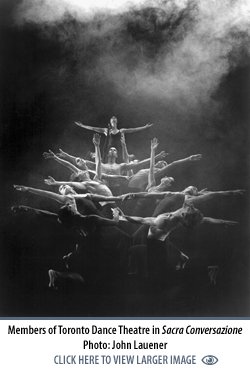Duration
28 minutes, 30 seconds
Composer:
W.A. Mozart
Music Title:
Requiem Mass K 626 (Introit, Kyrie, Dies Irae, Tuba Mirum, Recordare, Offertorium, Lacrimosa)
Costume Coordinator:
Julia Tribe
Lighting Designer:
Peter McKinnon
Premiere Date:
July 26, 1984, Banff Centre for the Arts
Premiere Location:
Eric Harvie Theatre, Banff Centre for the Arts
Cast:
Original cast, Banff: Allan Barry, Francine Liboiron, Jocelyn Paradis, Karin Wakefield, Lorna McConnell, Nancy Shainberg, Learie McNicolls, Jay Gower Taylor, Clark Blakley, Anita Bostok, Kenneth Cooper, Marilyn Gabriel, John-Eric Kent, Marie Josée Lecours, Laurence Lemieux, Jessica Manzo, Elaine Pollock, Dawn Pyke, Robyn Richards, Chip Seibert, Thomas Walker
Cast for Toronto Dance Theatre's premiere, March 18, 1986: Almond Small, Dennis (René) Highway, Monica Burr, Merle Holloman, Grace Miyagawa, Learie McNicolls, Karen duPlessis, Christopher House, Sylvie Bouchard, Michael Kraus, Suzette Sherman, with members of the School of Toronto Dance Theatre: Laurence Lemieux, Suzanne Landerman, Christiane Larouche, Ron Ladd
Summary Note
Sacra Conversazione was commissioned by the Banff Festival of the Arts, Banff School of Fine Arts and was performed by the Banff Centre Dance Performance Class with the Alberta Ballet Company. In 2002 Dance Collection Danse Magazine gathered a panel (Michael Crabb, Jeanne Renaud, Cathy Levy and Max Wyman) to consider and select the ten top Canadian choreographic masterworks of the 20th century; works that 'advance the art itself ' and trigger the audience's emotion, intellect and imagination. Sacra Conversazione was chosen as one of the ten.
Program Note
The first performance of this work is dedicated to Douglas Earle, my brother, who taught me the meaning of compassion. Many years ago, during a visit to France, I went to the Abbey of St. Denis, north of Paris, to see the tombs of the French Kings. As I stood amidst the fabulous white marble monuments, the great centre doors of the church opened on a scene of unforgettable poignance. A family dressed with all the dignity evident poverty would allow, stumbling wildeyed with grief, under the precious weight of a wooden coffin, entered the pantheon of French royalty from a violent, wind-blown, rain-lashed world. And on a wreath … 'à Jean 18 ans'. This vision is perhaps the seed of this work. Mozart died at 35 -- of poverty -- of neglect -- and left his Requiem Mass unfinished.
Interview with David Earle, December 3, 2002
There is a particular photograph in a book called The Family of Man that shows a community of Jews walking down the centre of the street -- probably on their way to a death camp -- scornfully watched by onlookers. If there was one central image in my creation of Sacra it was this targeted destruction. The Sacra program note relates an experience that moved me deeply at the Abbey of St. Denis in France, and the contrast between the white marble magnificence of the memorials and a grieving family's simple wooden casket. What I was trying to evoke in Sacra was the comparison between that scene and Mozart's great vaulting Requiem, which portrayed working class people. At the heart of my vision was humanity at its humblest and most sincere.
When Sacra was performed in Mexico and Venezuela, men from the audience came backstage in tears. The piece was all about community and going through tragedies and coming out the other side, a concept that they deeply understood. We were the first North American dance company to perform in Poland after the Berlin wall came down. We did fourteen curtain calls each night. As soon as we perform outside of southern Ontario we seem to do well. Works will find their audience if you just have the courage to keep presenting them.
Interview with dancer Suzette Sherman, December 3, 2002
Sacra made a great impression on the dancers as well as the audiences. Dancing it you felt that sense of journey and community. Many dancers were very devoted to Sacra allowing themselves to experience each performance as though for the first time. On tour Sacra was at the end of long, difficult programs and we often wondered where we would find the energy to sustain another thirty minutes of dancing. But the opening moments of Sacra drew us in and we would travel to the other end realizing that we had used our strength as a 'community'. The piece was incredibly powerful both emotionally and physically; from performing it most dancers learned a great deal about themselves, their dancing and the world.
Program Note from Toronto Dance Theatre Premiere, March 18, 1986
A people encountering violent death pass through feelings of grief and anger: they struggle to retain their unity and come to terms with their own mortality. Surely it is against the dark background of Death that our small flame of existence appears the most brilliant.
Review by Janet Martineau
Writing about the piece is difficult since it is an emotional experience rather than an intellectual one. There is no denying the powerful spiritual sense of Mozart's aching work, his last project before he himself dies, and what Earle has miraculously managed to do is choreograph it as one with the music. When a female soloist sings, a female soloist dances. As a male voice is added and the work becomes a duet, a male dancer joins the female soloist. Gradually it becomes a quartet, and then a full chorus, as dancers rise from the floor. As the music implores of the heavens, so do the bodies. As grief sounds through the notes, the bodies move as if pained beyond endurance. And as the music swells, the dancers sway to and fro … that magical uplifting, overpowering moment when dance and music become one and the soul quenches its insatiable thirst.
-- The Saginaw News (Michigan), 1990
![]()

